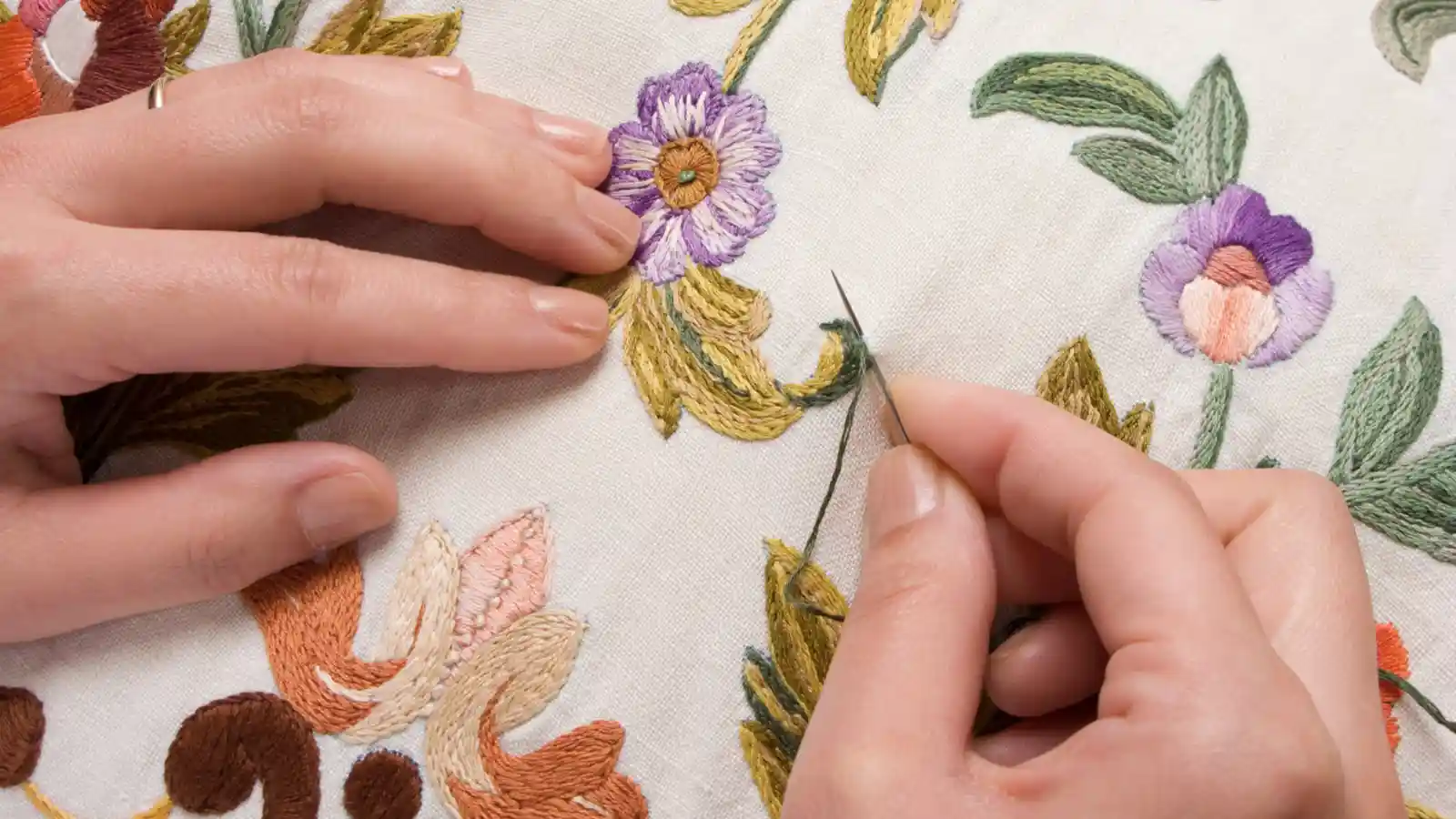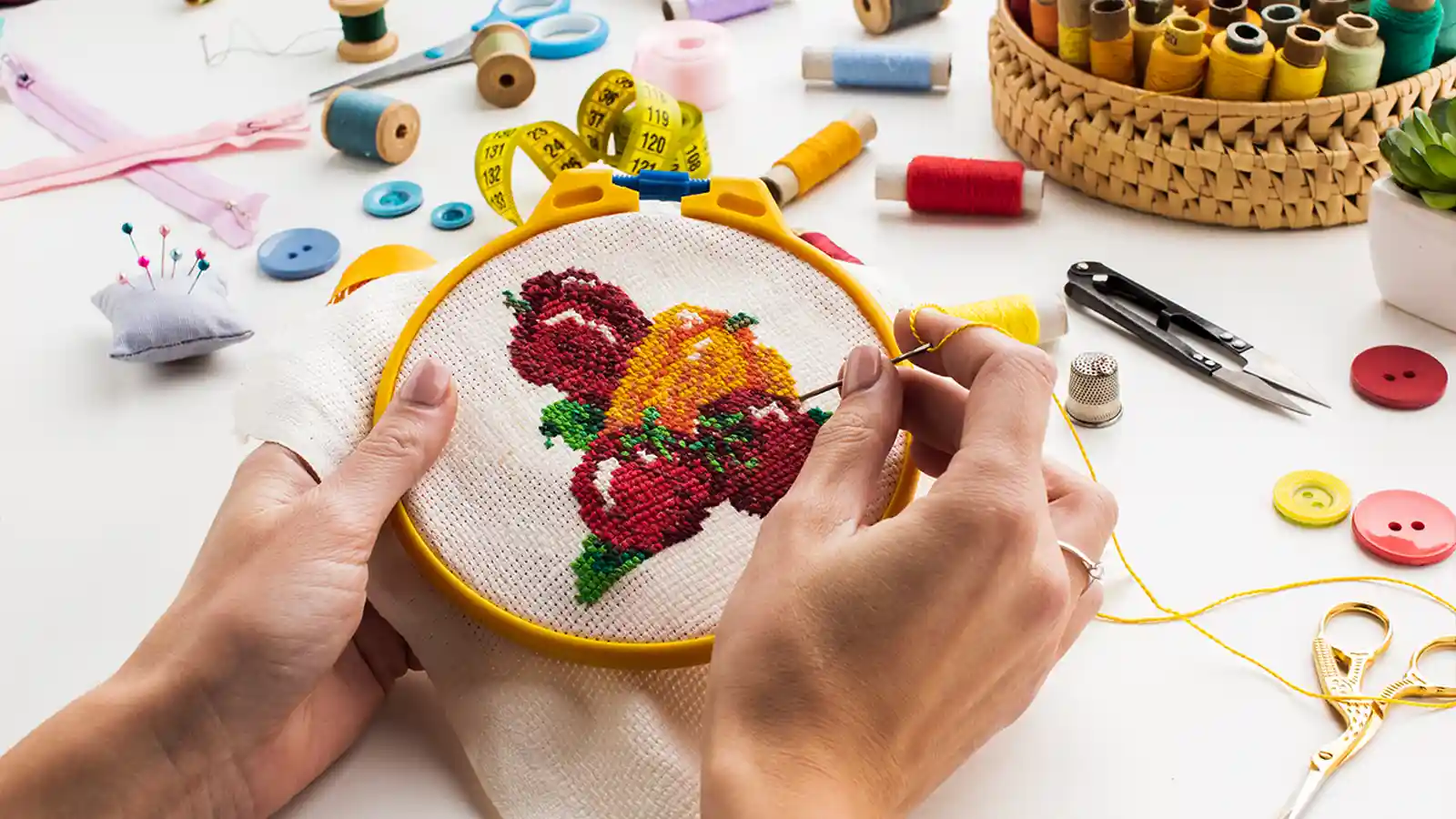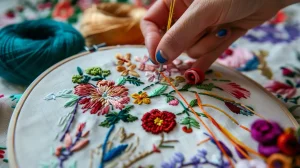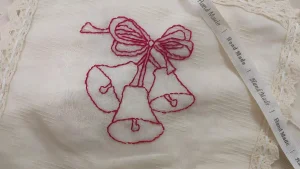Picture the shining threads of an embroidery piece dancing in the light beside the rich texture of a needlepoint canvas. Do you know what makes them different?
Both crafts use a needle and thread, but they differ in fabric, stitching techniques, and final appearance. In the forthcoming discussion, we’ll unravel these differences between embroidery and needlepoint. You will explore why you might choose one technique over the other.
Let’s explore what’s the difference between needlepoint and embroidery. Stay tuned: there’s more to stitching than meets the eye.
Key Takeaways
- Needlepoint uses yarn on canvas for durability and structure. Embroidery utilizes floss on various fabrics for detailed designs.
- Machine embroidery allows mass production, whereas hand embroidery offers personalized, traditional stitching techniques.
- Needlepoint utilizes structured stitching techniques. Embroidery employs a variety of stitches for intricate designs.
- Choosing between needlepoint and embroidery depends on personal preference, skill level, materials, design freedom, and desired artistic outcomes.
What is Embroidery?

Embroidery is a general term that includes many types. It involves cross-stitch, which is widely used. Embroidery is a decorative technique. It involves creating intricate designs on materials like linen, cotton, denim, and silk. Embroidery needs to use a needle and thread, often embroidery floss. As an art of decorating fabric, your fabric choice dramatically impacts the overall look and feel of the finished piece.
Embroidery floss is important for embroidery. So using high-quality brands is recommended for the best results. You’ll use various stitching techniques to create intricate designs, from the smooth satin stitch to the textured French knot.
Whether you’re embellishing a denim jacket or crafting a delicate silk handkerchief, embroidery provides a versatile and rewarding creative practice.
Types of Embroidery

You’ll encounter two main types of embroidery: machine and hand embroidery. Machine embroidery uses computer software to mass-produce intricate designs. Hand embroidery allows for more personalized, traditional stitching.
Understanding these two categories helps you appreciate the versatility and unique qualities each brings to fabric decoration.
Machine Embroidery
Machine embroidery uses computer software to create intricate designs with accuracy and speed. This method is commonly used in the clothing industry. It can accurately copy complex patterns onto different fabrics, such as wool, cotton, or polyester. Embroidery machines have become popular for the industry.
Logos on t-shirts, patterns on tote bags, and designs on wall hangings are often products of machine embroidery. Personal embroidery machines have also made their way into homes. It empowers hobbyists to create elaborate designs with ease.
Machine embroidery allows designs to be saved and reused. This increases efficiency for big embroidery projects, unlike traditional embroidery methods. This technology-driven embroidery technique thus offers a blend of speed, precision, and repeatability.
Hand Embroidery
Hand embroidery is a versatile and creative form of craft. It offers a unique allure, different from the speed and repeatability of machine embroidery. With just a needle and thread, you can transform simple fabric into an art of needlework. Cross-stitch is a type of hand embroidery that uses x-shaped stitches that span from one hole to the next on the fabric.
Hand embroidery allows you to create a wide range of embroidery stitches, from simple back-stitches to intricate French knots. Different fabrics, like linen or silk, offer various textures for your personalized designs. Cross-stitch and needlepoint belong to hand embroidery.
Hand embroidery isn’t just about creating beautiful artworks. It’s also a meditative and therapeutic process. The art of crafting offers many possibilities for creativity and allows you to personalize your fabric pieces.
What is Needlepoint?

Needlepoint is a special type of hand embroidery done on canvas with yarn or embroidery floss to create detailed designs. Needlepoint is a form of embroidery. Unlike traditional embroidery, needlepoint requires a more specific set of tools and materials.
Canvas is the foundation of your needlepoint project. It can be pre-printed with a pattern or left blank for your original creations. The type of stitch you choose further defines the texture and look of your piece. You will use embroidery floss or yarn with a tapestry needle, which has a larger eye than a typical embroidery needle.
These elements come together, stitch by stitch, to form the beautiful, detailed art of needlepoint.
Types of Needlepoint Stitches

As you learn more about needlepoint, you’ll come across different stitches. Each stitch has its own purpose and effect. There are multiple stitch types. Needlepoint stitches involve tent, basketweave, half-cross, continental, and gobelin stitches.
- The Tent stitch, a basic even stitch, is often the first you’ll learn. It’s simple, yet it lays the foundation for your needlepoint work.
- The basketweave stitch, on the other hand, provides a calming, meditative experience as you weave the thread through the canvas.
- The continental stitch adds texture and depth, creating a robust appearance in your design.
- Meanwhile, the gobelin stitch allows you to create interesting visuals by varying its length.
Mastering these needlepoint stitches will enable you to create intricate, stunning designs on canvas.
Differences Between Needlepoint and Embroidery

You might’ve observed that needlepoint and embroidery, while similar, are far from identical. The underlying fabric, the needle and thread used all differ significantly. Let’s take a closer look at these differences between the two types. It helps you decide which technique suits your crafting needs best.
The Way of Design Creation
What sets needlepoint and embroidery apart when it comes to design creation? The needlepoint design approach typically utilizes an open-weave canvas and tapestry wool. You may find pre-printed designs or choose to work with a blank canvas.
Embroidery often involves pre-printed designs on fabrics like satin or silk. The stitching methods also vary. Needlepoint involves hand-stitching yarn over the design area. Embroidery allows for both hand and machine stitching to create detailed shapes.
Your choice between these two techniques will depend on your expertise, preference, and desired results. Each one offers unique opportunities for creating decorative designs. Now start your canvas work.
Foundation Fabric
Let’s explore the fundamental difference in the fabric used in both needlepoint and embroidery.
In needlepoint, you typically work on an open-weave canvas. This canvas provides a grid-like structure for even stitching.
On the other hand, embroidery offers more versatility. You can embroider on various fabrics like satin, silk, cotton or even velvet. With embroidery, you’re provided with a wider range of textures and densities to adapt to your design.
While needlepoint’s canvas may be blank, embroidery designs often guide your stitching process. The choice between these two techniques largely depends on your desired outcome and expertise.
Needle Used
Different tools are used in needlepoint and embroidery. The choice of needle depends on the fabric and technique used.
In needlepoint, you primarily use tapestry needles with blunt tips. This is designed to pass smoothly through the canvas weave. This needle choice is essential for stitching on canvas fabric.
On the other hand, embroidery often calls for sharp-tipped needles. These allow for precise and intricate stitching on various fabrics, such as silk, satin, or cotton.
The type of needle used shows the technique and fabric choice in needlepoint and embroidery. It highlights their unique characteristics and differences.
Thread Used
When comparing needlepoint and embroidery, it is important to focus on the different types of thread used in each technique.
Needlepoint uses yarn, typically a thicker, more robust choice. This is designed to provide durability and texture on the canvas. Your thread choice in needlepoint is crucial for the overall look and feel of your finished piece.
On the other hand, embroidery uses floss. This option is better, comes in more colors, and is designed for intricate designs on fabrics such as satin, silk, and cotton. The thread choice in embroidery can dramatically alter the final product. The versatility of embroidery threads allows for an intricate level of detail, making your work truly unique.
Creation Methods
Exploring the creation methods of needlepoint and embroidery, you’ll find striking contrasts in the foundations of these two techniques. Needlepoint is a type of embroidery that uses yarn to stitch over a design area on canvas. The canvas can be blank with an open-weave. It’s a handwork art, bringing a unique charm to each piece.
On the other hand, embroidery offers more flexibility. You can use floss to stitch over lines and fill shapes. You can do this by hand or using a machine. Different fabrics like satin, silk, or cotton can be used. This allows for a broader range of creative expression.
Different Types of Stitching Techniques
You can see differences in how they are made, and the stitches used in needlepoint and embroidery. Needlepoint is unlike the endless possibilities of embroidery. Needlepoint mainly uses structured stitches like tent and basketweave to create a textured and durable finish. Embroidery is similar to cross stitch. It uses different stitches like back stitch, satin stitch, and French knots to create detailed designs. Needlepoint requires filling the canvas with even stitches. Embroidery allows for freestyle surface stitching, providing more design options.
Durability
Needlepoint is more durable than embroidery because it uses a strong canvas fabric. This sturdy base allows for tighter, more secure stitches, enhancing the longevity of your design. The open weave of the canvas provides a structured foundation. This makes your needlepoint piece more resistant to wear and tear. Conversely, the variability of embroidery’s fabric choices can compromise its durability.
Embroidery can be done on fabrics like satin, silk, or cotton. But these materials may not last as long as needlepoint canvas. Needlepoint is durable and suitable for frequent use or to endure stress.
Which Type of Embroidery Do you Choose?
Deciding between needlepoint and embroidery depends on your personal preference, skill level, and the artistic outcome you want to achieve. If you’re seeking a structured approach, needlepoint might be your best bet. The commonly used stitch in needlepoint, the tent stitch, provides a uniform, grid-like pattern, ideal for geometric designs.
On the other hand, the type of embroidery you choose can vary significantly. Embroidery is also versatile and offers a wide range of stitches like French knots and satin stitch, which are ideal for intricate designs.
Conclusion
You’ve explored the worlds of embroidery and needlepoint. Both offer distinct styles, techniques, and aesthetics.
Needlepoint, with its wool on canvas approach, is great for bold, full designs. Embroidery’s varied threads and softer fabrics let you play with textures and details.
Your choice depends on your style, skills, and vision. Remember, there’s no wrong choice – only the thrill of creating something uniquely yours. Embroidery is the art that you can create exquisite art work. Now pick your needlepoint kits for your next project.
So, ready to pick up that needle and thread?



